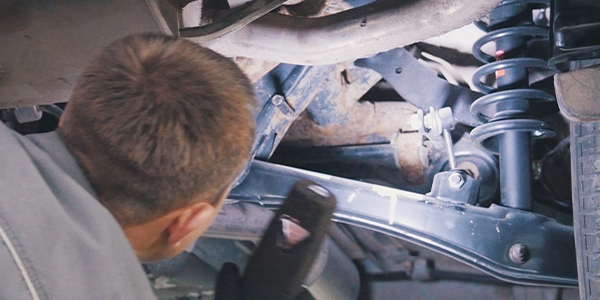Shock absorber replacements are unique because they represent a big ticket, high profit margin, low liability sales opportunity that happens at least once or perhaps twice during the normal service life of a typical vehicle. Modern shock absorber design is also becoming much more sophisticated than it was just one short decade ago. In conventional applications, a shock absorber may be independently mounted, serving only as a dampening device for coil- or leaf-type springs.
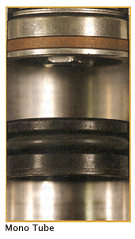 During the past several decades, MacPherson strut shock absorbers have routinely become part of the modern suspension system. Most recently, original equipment shock absorbers are being designed as load-leveling devices as well as interactive suspension devices used to control nosedive and body roll during severe driving situations.
During the past several decades, MacPherson strut shock absorbers have routinely become part of the modern suspension system. Most recently, original equipment shock absorbers are being designed as load-leveling devices as well as interactive suspension devices used to control nosedive and body roll during severe driving situations.
Three basic designs are used on modern vehicles: Conventional twin-tube; gas-charged, twin-tube; or single- or mono-tube gas-charged shock absorbers. In the conventional design, a shock absorber is built with an inner and outer tube. A piston pushes fluid up and down in the inner tube to dampen spring oscillations, with the outer tube serving as a fluid reservoir for the inner tube.
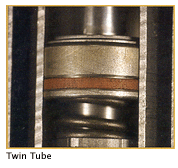 More recent designs use the outer tube not only as a fluid reservoir, but also to hold a charge of nitrogen gas to reduce foaming action in the fluid and to smooth out the dampening action of the shock absorber. Because the pressurized gas in these shock absorbers actually applies pressure to the piston and piston shaft, the “gas” shock absorber slightly increases the suspension height of the vehicle.
More recent designs use the outer tube not only as a fluid reservoir, but also to hold a charge of nitrogen gas to reduce foaming action in the fluid and to smooth out the dampening action of the shock absorber. Because the pressurized gas in these shock absorbers actually applies pressure to the piston and piston shaft, the “gas” shock absorber slightly increases the suspension height of the vehicle.
Last, the single- or mono-tube high-pressure gas shock absorbers apply the gas charge directly to the top of a piston that separates the hydraulic oil and pressurized gas. This design eliminates fluid foaming and what is termed shock absorber “fade.”
Each of these three basic designs offers different advantages, depending upon the specific application. A sport-utility vehicle that is used for towing a camper trailer or boat may, for example, require different dampening characteristics than a family car.
A shock absorber’s dampening characteristics are determined primarily by piston size, valving and fluid capacity. Larger piston sizes are generally used for improving suspension control in trucks and other heavy vehicles. The valving in the shock absorber determines the ratio between the compression and extension of the shock absorber. This compression and extension ratio generally determines the ride and performance characteristics of the shock absorber.
Many modern shock absorber designs also incorporate velocity-sensitive valving that allows the wheels to glide over minor road surface irregularities. But, when piston velocity increases when the wheel hits a severe bump, the valving readjusts to a firmer rate within a fraction of a second. In other applications, the shock absorber may be externally adjustable to allow the technician to customize the shock valving to the customer’s preferences.
Because so many designs are now on the market, it’s best to reconcile the customer’s expectations with the shock manufacturer’s recommendations before ordering or installing any particular shock absorber configuration. Most consumers prefer a “factory” ride. On the other hand, most performance or off-road enthusiasts prefer a firm ride and a minimum of body roll during cornering maneuvers.
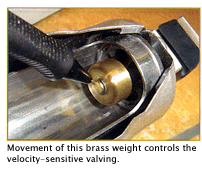 How does a shop diagnose worn shock absorbers? The answer isn’t simple. Many racing teams are now using shock absorber dynamometers to test how well a shock absorber will maintain its effectiveness throughout a long race. New drive-on shock tester for shops are dropping in price every year. But, testing old shocks with a quick visual check usually reveals most of the symptoms associated with worn shock absorbers.
How does a shop diagnose worn shock absorbers? The answer isn’t simple. Many racing teams are now using shock absorber dynamometers to test how well a shock absorber will maintain its effectiveness throughout a long race. New drive-on shock tester for shops are dropping in price every year. But, testing old shocks with a quick visual check usually reveals most of the symptoms associated with worn shock absorbers.
First, use a tape measure to check the distance from the floor to a common reference point on the body, such as the upper lip of the fender well. If a difference in ride height is indicated, the shock absorber may have lost its gas charge, or the vehicle may have a sagging spring.
When disconnected from the chassis, a shock absorber with a full gas charge will quickly extend the piston rod. In other failure scenarios, a shock absorber may “stick” up or down due to a broken piston assembly. Next, check for oil leakage around the shaft seal (see photo 1). If the oil leakage looks wet, or covers the length of the shock absorber body, the shocks should be replaced either in axle pairs or at all four wheels.
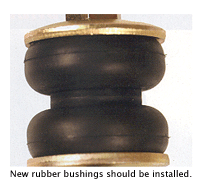 Rebound recovery tests, unfortunately, are a far more subjective type of shock absorber evaluation. During a rebound test, the suspension is cycled by placing the knee or hands on the front or rear bumper of the vehicle, bouncing the suspension and then observing the recovery rate. In theory, good shock absorbers should dampen spring bounce within one oscillation cycle. In reality, a technician should be very familiar with the suspension characteristics of the nameplate in question. Some auto manufacturers design soft suspensions; others design firm suspensions, depending upon model application.
Rebound recovery tests, unfortunately, are a far more subjective type of shock absorber evaluation. During a rebound test, the suspension is cycled by placing the knee or hands on the front or rear bumper of the vehicle, bouncing the suspension and then observing the recovery rate. In theory, good shock absorbers should dampen spring bounce within one oscillation cycle. In reality, a technician should be very familiar with the suspension characteristics of the nameplate in question. Some auto manufacturers design soft suspensions; others design firm suspensions, depending upon model application.
If a chucking or knocking noise is detected during the rebound recovery test, at least one shock absorber may have a loose piston, a worn piston shaft bushing or worn mounting bushings. When the shock’s rebound bumpers are worn or the tires show a mild cupping in the center of the tread (see photo 2), shock absorber fade may be occurring when the shock absorber fluid becomes overheated and loses viscosity during a long trip.
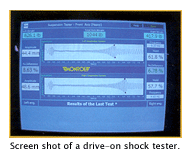 When road testing, the most accurate observations are achieved by driving the vehicle over the same stretch of road. Worn shock absorbers will cause the vehicle to nose-dive during braking or roll during cornering maneuvers. Again, the “feel” of worn shock absorbers tends to be a subjective judgment that requires familiarity with the specific vehicle nameplate and application.
When road testing, the most accurate observations are achieved by driving the vehicle over the same stretch of road. Worn shock absorbers will cause the vehicle to nose-dive during braking or roll during cornering maneuvers. Again, the “feel” of worn shock absorbers tends to be a subjective judgment that requires familiarity with the specific vehicle nameplate and application.
HOW SHOCK ABSORBERS FAIL
How do shock absorbers fail? In most cases, the piston shaft seal fails and allows the fluid to leak out of the shock’s oil reservoir. On high-mileage vehicles, the internal parts, such as the piston seal or valving, wear out, which alters the dampening characteristics of the shock absorber. Last, the nitrogen charge may leak from the shock absorber, which slightly lowers the suspension height and allows the fluid to foam during normal operating conditions. All of the above failures will, at some point in the shock absorber’s service life, cause the shock absorber fluid to become overheated or foam during severe operating conditions or extended trips.
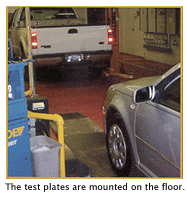 Last, the piston itself can become disconnected from the shock absorber shaft. The shaft may then bend, which causes the shock absorber to bind at some point in its travel. Because some pistons are held onto the shaft by a threaded nut, tightening the piston shaft bushings or spinning the piston shaft with an impact tool may loosen the piston-retaining nut. The best alternative is to buy the appropriate tools needed to hold the piston shaft stationary while the retaining nut is being tightened.
Last, the piston itself can become disconnected from the shock absorber shaft. The shaft may then bend, which causes the shock absorber to bind at some point in its travel. Because some pistons are held onto the shaft by a threaded nut, tightening the piston shaft bushings or spinning the piston shaft with an impact tool may loosen the piston-retaining nut. The best alternative is to buy the appropriate tools needed to hold the piston shaft stationary while the retaining nut is being tightened.
Last, it’s always important to make sure that the vehicle’s front and rear springs aren’t weak or broken. Springs that aren’t up to the demands being placed upon them will dramatically shorten shock absorber life. The spring and shock absorber are lifetime partners and should be treated as such.
RELATED SALES
When selling MacPherson struts or shock absorbers:
Remember that replacing dry or worn bearing plates is a highly recommended add-on. Worn plates can develop a steering “memory,” which alternately causes a right- and left-hand steering pull on MacPherson strut suspensions.
Don’t forget to include protective boots and rebound bumpers on the estimate for applicable MacPherson strut or shock absorber replacements.
When replacing shock absorbers, always check for uneven suspension height caused by weak or broken springs. Weak springs will cause premature shock failure.
Keep in mind that worn shock absorbers accelerate wear throughout the steering linkage and suspension systems.
Out-of round, out-of-balance tires and wheels will aggravate shock absorber fade and diminish the ride and handling qualities of new shock absorbers.
When selling new shock absorbers, always consider the shock absorbers, steering and suspension systems, and wheels and tires as an integral system.











